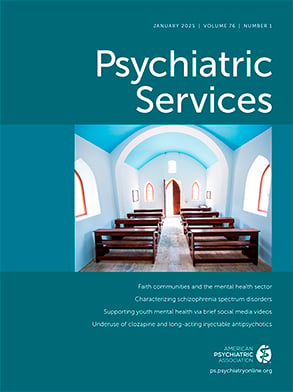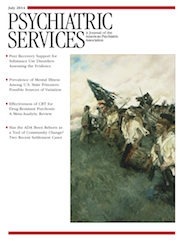Approximately 10% of U.S. adults now fill one or more antidepressant prescriptions each year (
1,
2), with 75% of these prescriptions being written by nonpsychiatrists (
1,
3). Recent reports have raised concerns about increasing rates of antidepressant use and have suggested that antidepressants may often be prescribed in the absence of an evidence-based indication. Using data from several large community surveys, Pagura and colleagues (
4) reported that 26% of U.S. residents using antidepressant medication did not appear to have any lifetime history of a psychiatric diagnosis. Because individuals frequently do not recall past depressive episodes (
5), those community surveys might misclassify respondents with successfully treated depression as having no lifetime history. Using data from the 2007 U.S. National Ambulatory Medical Care Survey (NAMCS), Mojtabai and Olfson (
6) reported that no psychiatric diagnosis was recorded for over 70% of visits at which an antidepressant was prescribed. NAMCS data, however, capture only diagnoses assigned at the sampled visit. Consequently, antidepressant-using patients who received a diagnosis at a previous visit could be misclassified as having no appropriate indication for antidepressant treatment.
In this study we used data from ten large health systems to examine diagnoses received by health plan members who filled prescriptions for antidepressant drugs. We linked prescription data with diagnostic data from patient encounters to examine all diagnoses received over a calendar year.
Methods
The Mental Health Research Network (MHRN) is a consortium of public-domain health systems affiliated with large integrated health care systems, including six Kaiser Permanente regions (Colorado, Georgia, Hawaii, Northern California, Northwest, and Southern California) as well as Group Health Cooperative, Harvard Pilgrim Health Care, HealthPartners, and the Henry Ford Health System. The combined populations served by these health systems include approximately 11 million members residing in 12 states. Institutional review boards at all sites granted either waivers or exemptions for this use of deidentified medical records data.
Insurance coverage data from each health system were used to identify all members who were enrolled for at least ten months during 2010 and who had prescription drug coverage during 2010. Those 8,926,781 members included approximately 13% insured by Medicare, 4% by Medicaid, and 68% by employer-sponsored insurance; the remaining members were insured by individual insurance or other state-sponsored programs.
Combined pharmacy dispensing and claims data were used to identify all members filling one or more prescriptions for any antidepressant drug in 2010. Antidepressant drugs were defined to include all drugs approved by the U.S. Food and Drug Administration (FDA) for initial treatment of major depressive disorder as well as a few medications not approved for treatment of depression but having substantially similar chemical and clinical effects (such as fluvoxamine and clomipramine). Tricyclic antidepressants, trazodone, and bupropion were examined separately because these drugs are often prescribed for nonpsychiatric indications (
7).
Combined electronic medical record and claims data were used to identify all outpatient or inpatient diagnoses of mental health conditions recorded in 2010. We identified four groups of specific psychiatric diagnoses for which antidepressants might be prescribed: depressive disorders (ICD-9 codes 296.20–296.36, 300.4, 309.0, 309.28, and 311), anxiety disorders (ICD-9 codes 300.00–300.02, 300.21, 300.22–300.24, 300.3, 309.21, 309.24, and 309.81), bipolar disorders (ICD-9 codes 296.00–296.06, 296.40–296.89, and 301.13), and attention deficit disorders (ICD-9 diagnoses 314.0–314.9). We also identified individuals receiving any psychiatric diagnosis (ICD-9 codes 290.0–316).
Results
As shown in
Table 1, the procedures described above identified more than one million health plan members who filled one or more antidepressant prescriptions in 2010. This included approximately 480,000 filling prescriptions for antidepressants often prescribed for nonpsychiatric indications (tricyclic antidepressants, trazodone, or bupropion) and approximately 710,000 filling prescriptions for other antidepressants. Some individuals were included in both groups. Forty-eight percent of those filling at least one prescription for any antidepressant drug received at least one diagnosis of a depressive disorder. Twenty-seven percent received at least one diagnosis of any anxiety disorder, and the proportions receiving diagnoses of a bipolar disorder or an attention deficit disorder were 3% each. Among those who filled a prescription for any antidepressant, 39% received no psychiatric diagnosis during the year. Across the ten MHRN health systems, this proportion ranged from 33% to 45%.
As expected, the proportion of persons using antidepressants who received no psychiatric diagnoses was larger (48%) for those using tricyclic antidepressants, trazodone, or bupropion than for those using other antidepressants (approximately 27%). This pattern was also similar across the ten health systems (details available on request).
As shown in
Table 1, the prevalence of specific psychiatric diagnoses among those prescribed antidepressants varied by age. As expected, the proportion of patients with attention deficit disorder diagnoses was much higher among children and adolescents (25%) than among adults. The proportion with no recorded psychiatric diagnosis also varied by age, ranging from 11% among children and adolescents to 25%–30% among middle-aged and older adults.
Discussion and conclusions
We found that 39% of health plan members who filled antidepressant prescriptions during 2010 received no psychiatric diagnosis during that year. After antidepressant drugs commonly prescribed for nonpsychiatric indications (tricyclic antidepressants, trazodone, and bupropion) were excluded, the proportion with no psychiatric diagnosis decreased to 27%. Although this proportion is certainly not trivial, it is far smaller than the 70% with no psychiatric diagnosis reported by Mojtabai and Olfson (
6). We suspect that the difference between these estimates reflects our methodology, which captured all diagnoses during a calendar year rather than those from a single visit. Our estimate of the proportion of antidepressant users without a psychiatric diagnosis is similar to that reported by Pagura and colleagues (
4), but we should emphasize that our analysis examined diagnoses in the same calendar year rather than lifetime diagnoses. If records data allowed us to examine diagnoses at any point in life, the proportion of antidepressant users without psychiatric diagnoses would certainly be smaller than reported here.
Our methods probably underestimated the true rate of psychiatric diagnoses among individuals who filled an antidepressant prescription. First, we might not have identified psychiatric diagnoses recorded when treatment was initiated (for example, diagnoses recorded in late 2009 among patients filling prescriptions in early 2010). Second, we were not able to identify diagnoses for inpatient or outpatient services that were not provided or covered by the health plan (for example, services covered by other insurance sources or paid for entirely out of pocket). Third, prescribing providers may have sometimes recognized or diagnosed depression or another mental health condition but chosen not to record a diagnosis.
In addition, we should emphasize that some antidepressant prescribing for nonpsychiatric indications is expected and supported by reasonable evidence. Although such nonpsychiatric indications may be more common for tricyclic antidepressants, trazodone, and bupropion, FDA-approved nonpsychiatric indications do exist for other antidepressants (for example, premenstrual dysphoric disorder for fluoxetine and pain conditions and fibromyalgia for duloxetine).
On the basis of the visit diagnosis data available, we could not assess the severity of mental health conditions. Consequently, we cannot determine what proportion of individuals receiving depression diagnoses had symptoms of depression or anxiety severe enough to warrant treatment with medication.
These analyses did not evaluate the quality or continuity of care for individuals receiving antidepressant medication. Previous research suggests that early discontinuation of antidepressant medication is common and that many patients who start antidepressant treatment make few, if any, return visits to the prescribing provider (
8–
10). The latter scenario (no return visits after the initial prescription) could explain some cases of antidepressant prescription refills not accompanied by any psychiatric diagnosis if patients who received a diagnosis in 2009 continued to fill prescriptions in 2010.
Significant concerns persist regarding quality of antidepressant treatment, including frequent nonadherence and infrequent follow-up care (
11). However, frequent prescribing of antidepressants for inappropriate indications is probably not highest on that list of concerns.
Acknowledgments and disclosures
The Mental Health Research Network is supported by a cooperative agreement with the National Institute of Mental Health (U19 MH092201).
The authors report no competing interests.

